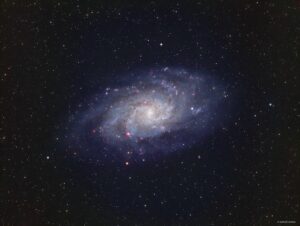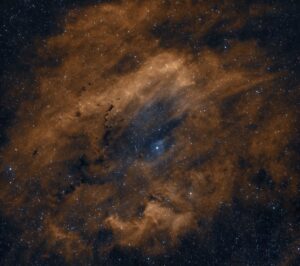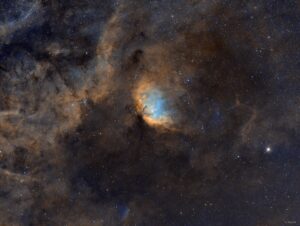
“The Cosmos is all that is or was or ever will be. Our feeblest contemplations of the Cosmos stir us — there is a tingling in the spine, a catch in the voice, a faint sensation, as if a distant memory, of falling from a height. We know we are approaching the greatest of mysteries.”
― Carl Sagan
“The man in the street does not know a star in the sky.”
— Ralph Waldo Emerson
I am often asked why I spend many of my free hours peering through my telescope in the deep of night. My answers vary from the mystical to the practical, yet there is something deeply compelling that is difficult to put into words. There is beauty and simplicity. The universe is a masterpiece that is so often overlooked. In this short essay, I would like to introduce you to this wonderful hobby and share with you some of my thoughts and images.

Learning the Night Sky
To the average person, the night sky is a random maze of twinkling pinpoints of light. It seems that Emerson’s quote is perhaps even more apropos today. Every so often, I am approached by someone curious about backyard astronomy. My first recommendation is to learn the night sky. Just as during the study of anatomy, the nervous system transformed from the intimidating to the familiar, finer details became apparent and we became enamored by its beauty and mystery; so it is with astronomy. There comes a magical night when the sky ceases to be random points of light and transforms into a familiar scape containing known planets, stars, nebulae and galaxies. A basic sky chart and binoculars are all that is needed to transform the starry night into a mesmerizing blaze of colorful gems on black velvet. The moon’s craters come to into stark relief and Jupiter and the nightly dance of its moons can be observed and many colorful star clusters come to life (Figure 1).
Probing the Depths
After binoculars and learning the sky, there is usually the impetus to obtain a telescope. There is something captivating about seeing a celestial wonder through a telescope a vividness and “realness” that must be experienced to understand. The moon takes on an almost three-dimensional appearance, and the wealth of detail is staggering. Jupiter reveals its cloud bands and great red spot. The Galilean moons put on an ever-changing display as they orbit. Saturn is the showstopper. No one forgets their first view of Saturn; the delicate rings seen encircling the sphere are both magical and ethereal.
Beyond the solar system lies the realm referred to as the deep sky. There are numerous catalogs of objects comprised of star clusters, nebulae and galaxies. Unfortunately, apart from star clusters, most of these objects are dim and colorless. Many beginners are disappointed in their first view of these objects through a telescope. Most deep sky objects are on the threshold of visual perception. They appear dim and faint; ghostly white clouds lacking the detail and color of photographs. As with surgery, it takes time and training to pick out details that are initially unrecognized. Eventually, the subdued appearance and experience is appreciated. With experience, a good instrument and a dark sky, many of these objects provide a glorious sight despite the limitations of the human eye. The Orion Nebula and Triangulum Galaxy are two such examples.

The Orion Nebula is the nearest and brightest nebula, lying 1,400 light years from earth (Figure 2 – top photo). The view through the telescope, initially featureless, gradually builds; at first, it is just a bright patch around a trapezoid of tiny stars. As the eye gathers photons, cloud-like features appear, delicate rifts and ripples become obvious within the ghostly gray-green cloud. The delicate glow of the tendrils among dark lanes never gets old for me. Similarly, the Triangulum Galaxy appears as a featureless glowing island, lacking the magnificent details seen in long exposure photographs (Figure 3). With experience, the bright nucleus and spiral arms become evident.

Astrophotography
Producing beautiful images of deep sky objects is the hobby within the hobby. This addictive and often frustrating endeavor is said to exist at the intersection of science, art, information and aesthetics. Long exposure astrophotography pushes photography to its limits. It comes with a host of technical difficulties and nuances not possible to detail in this short article; light pollution, weather, satellite trails, mount tracking errors, optical aberrations and image processing difficulties are just a few. For me, it is a labor of love. The technophile appeal of setting up and tweaking my gear (Figure 4) outweighs the mosquito bites of summer or the frozen fingers of winter. I am always awestruck while watching the data come together revealing the complex structure and delicate beauty of these night sky gems (Figures 5, 6 and 7).

The why?
In the quiet of night, as I stare at the canopy of blazing suns above, I am struck by the realization that the earth is but a speck of debris drifting through a vast void. I am captivated by attempting to understand our place in the universe. The realization that “we,” who can contemplate the very nature of the universe and to some degree unravel some of its governing rules, is astonishing. As Carl Sagan said, “The cosmos is within us. We are made of star-stuff. We are a way for the universe to know itself.” Is ours a special place? Who else may be out there contemplating the same? When I am lost in the night sky, tranquility reigns, I commune with the universe and I am transported to a place where everyday problems seem irrelevant.









